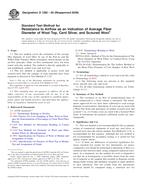We need your consent to use the individual data so that you can see information about your interests, among other things. Click "OK" to give your consent.
ASTM D1282-05(2009)
Standard Test Method for Resistance to Airflow as an Indication of Average Fiber Diameter of Wool Top, Card Sliver, and Scoured Wool (Withdrawn 2018)
Automatically translated name:
Standard Test Method for Resistance to Airflow as an Indication of Average Fiber Diameter of Wool Top, Card Sliver, and Scoured Wool
STANDARD published on 1.7.2009
The information about the standard:
Designation standards: ASTM D1282-05(2009)
Note: WITHDRAWN
Publication date standards: 1.7.2009
SKU: NS-16865
The number of pages: 9
Approximate weight : 27 g (0.06 lbs)
Country: American technical standard
Category: Technical standards ASTM
The category - similar standards:
Annotation of standard text ASTM D1282-05(2009) :
Keywords:
air-flow, diameter, wool, Airflow resistance, Diameter--textile fabrics/fibers, Micronaire reading, Port-Ar readings, WIRA fiber fineness instrument, Wool and wool top--fiber diameter, ICS Number Code 59.060.10 (Natural fibres)
Additional information
| Significance and Use | ||||||||||||||||||||||||||||||||||||||||||||||||||||||||||||||||||||||||
|
This test method is not recommended for the acceptance testing of commercial shipments of wool top, card sliver, or scoured wool since the referee method, Test Method D 2130, is recommended for that purpose. Although this test method is not recommended for acceptance testing, it is useful for fast quality control checks. .If there are differences of practical significance between reported test results for two laboratories (or more), comparative test should be performed to determine if there is a statistical bias between them, using competent statistical assistance. As a minimum, use the samples for such a comparative test that are as homogenous as possible, drawn from the same lot of material as the samples that resulted in disparate results during initial testing and randomly assigned in equal numbers to each laboratory. The test results from the laboratories involved should be compared using a statistical test for unpaired data, a probability level chosen prior to the testing series. If bias is found, either its cause must be found and corrected, or future test results for that material must be adjusted in consideration of the known bias. The specific area of the wool fibers is measured by the resistance in air flow. The resistance to air flow has been related to average fiber diameter measured by the microprojection method. The instruments have been calibrated to read average diameter in micrometres. Although the reading is affected by the average fiber diameter distribution of the specimen, the results secured by the instruments give no indication of this distribution. However, in converting the micrometres reading to millitex units (Annex A1), low, medium, and high standard deviations were used in the calculations to arrive at the range of millitex units which accordingly reflect the distribution of fiber diameters.
|
||||||||||||||||||||||||||||||||||||||||||||||||||||||||||||||||||||||||
| 1. Scope | ||||||||||||||||||||||||||||||||||||||||||||||||||||||||||||||||||||||||
|
1.1 This test method covers the estimation of the average fiber diameter of wool fibers by use of the Port-Ar and the WIRA Fiber Fineness Meter instrument, which operate on the air-flow principle. Other air-flow instruments have not been tested with this method. The method is directly applicable to non-medullated, carded wool and wool top. 1.2 This test method is applicable to grease wool and scoured wool after the samples of such materials have been prepared as directed in Test Method D 2130. Note 1—The
use of the Micronaire instrument for measuring the fineness of
cotton fibers is covered in Test Method D 1448. 1.3 This standard does not purport to address all of the safety concerns, if any, associated with its use. It is the responsibility of the user of this standard to establish appropriate safety and health practices and determine the applicability of regulatory limitations prior to use. |
||||||||||||||||||||||||||||||||||||||||||||||||||||||||||||||||||||||||
| 2. Referenced Documents | ||||||||||||||||||||||||||||||||||||||||||||||||||||||||||||||||||||||||
|
||||||||||||||||||||||||||||||||||||||||||||||||||||||||||||||||||||||||
We recommend:
Technical standards updating
Do you want to make sure you use only the valid technical standards?
We can offer you a solution which will provide you a monthly overview concerning the updating of standards which you use.
Would you like to know more? Look at this page.




 Cookies
Cookies
